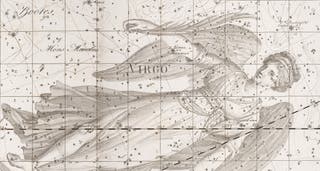Bayer, Johann. Explicatio...Uranometrias. Augsburg, 1654.
One of the great innovations of the 1603 edition of Bayer's Uranometria was the inclusion of tables containing the nomenclature, descriptions, and magnitudes of the stars in each constellation. These tables, coupled with the charts that carefully positioned the stars with their new labels on a grid, made the Uranometria the first true star atlas.
But there was a problem with the Uranometria as originally printed. For some reason, the tables were printed on the verso (back) of the appropriate plate, making it difficult to refer from plate to text without considerable flipping of pages. Indeed, if we look at a detail of the plate of Andromeda, we can see the star table showing through the printed page. Thus it was impossible to consult both chart and table simultaneously. In all later editions of the Uranometria, the versos of the plates were left blank, and the tables were printed separately. The first set of such tables was published in 1624; the copy on exhibit is a second edition.

